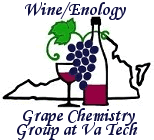 Enology Notes #59, August 29, 2002
Enology Notes #59, August 29, 2002
To: Regional Wine Producers
From: Bruce Zoecklein, Head, Enology-Grape Chemistry Group, Virginia Tech
Subject: The 2002 Vintage and Red Wine Quality; Red Wine HACCP Planning; New - Enology Notes Subject Index
The 2002 Vintage and Red Wine Quality. Red wine quality is, in part, a function of phenol development and management. The best temperature for phenol development during stage 3 ripening is below the temperature of optimum vine growth.
The cool weather we are now experiencing may be quite desirable for phenol development, depending upon the current level of maturation.
Phenol production is the result of enzymatic activity in the plant. This activity increases in low and intermediate temperature ranges, but falls at high temperatures. Very high temperatures, such as in sun-exposed fruit in warm climates, may completely stop enzyme activity.
An optimum mean temperature for ripening grapes is about 20°C (68°F) or slightly higher. It is a little below the mean temperature of around 23-25°C (73--77°F) at which grape vines reach their greatest rate of photosynthesis and growth.
Below around 23-25°C, a surplus of sugars can accumulate which is available to be stored or transported to the fruit, or to be used as so-called luxury products (such as aroma/flavor and phenol compounds) not essential for plant growth.
However, as the temperature increases above the optimum, the demand for sugar due to rapidly accelerating respiration, combined with no further increase in the rate of photosynthesis, results in a smaller amount of sugar for growth and luxury products.
This is why anthocyanins disappear at high growing temperatures. The maximum rate of pigment synthesis depends on a good supply of sugar, together with favorable intermediate temperatures for maximum enzyme activity.
A strong positive correlation has been found between minimal difference in day and night temperatures, and pigment development and concentration. This is one of the reasons we are interested in evaluating the relationship between day and night temperature differential in Virginia.
Anthocyanin pigment concentration in the skin is not influenced by sun exposure as much as are non-colored phenols. Example, flavonol phenols (which can contribute substantially to bitterness) can be increased in concentration by a factor of 20 or more by increased sun exposure. This is a major reason why we should be more focused with regard to selective leaf removal. As has been discussed at Winemaker Roundtable meetings, optimum leaf removal well depends on the cultivar, wine style, row orientation and side of the grapevine canopy.
Red Wine HACCP Planning. An outline of HACCP (Hazard Analysis Critical Control Point) planning from the Pre-harvest Workshop is posted on my web site. Go to Extension, then on-line publications.
Some of the important red wine production considerations include the following:
Each production parameter should be reviewed in the context of the cultivar and vineyard ‘expression’ and the type and style of wine produced.
New - Enology Notes Subject Index. A new index has been posted on the Enology-Grape Chemistry Group’s web site (www.vtwines.info) which provides a subject list for all Enology Notes.
Subscription to Enology Notes. All past Enology Notes and Vintner's Corner newsjournals are posted on the Enology-Grape Chemistry Group's web site at: http://www.fst.vt.edu/zoecklein/index.html or http://www.vtwines.info/. Enology Notes are slightly different in content from the subscription based Vintner's Corner newsjournal.
To be added to the Enology Notes list serve send an email message to bzoeckle@vt.edu with the word "ADD" or "REMOVE" in the subject line.
Dr. Bruce Zoecklein
Associate Professor and Enology Specialist
Head Enology-Grape Chemistry Group
Department of Food Science and Technology
Virginia Tech
Blacksburg VA 24061
Enology-Grape Chemistry Group Web address: www.vtwines.info or www.fst.vt.edu/zoecklein/index.html
Phone: (540) 231-5325
Fax: (540) 231-9293
Email: bzoeckle@vt.edu